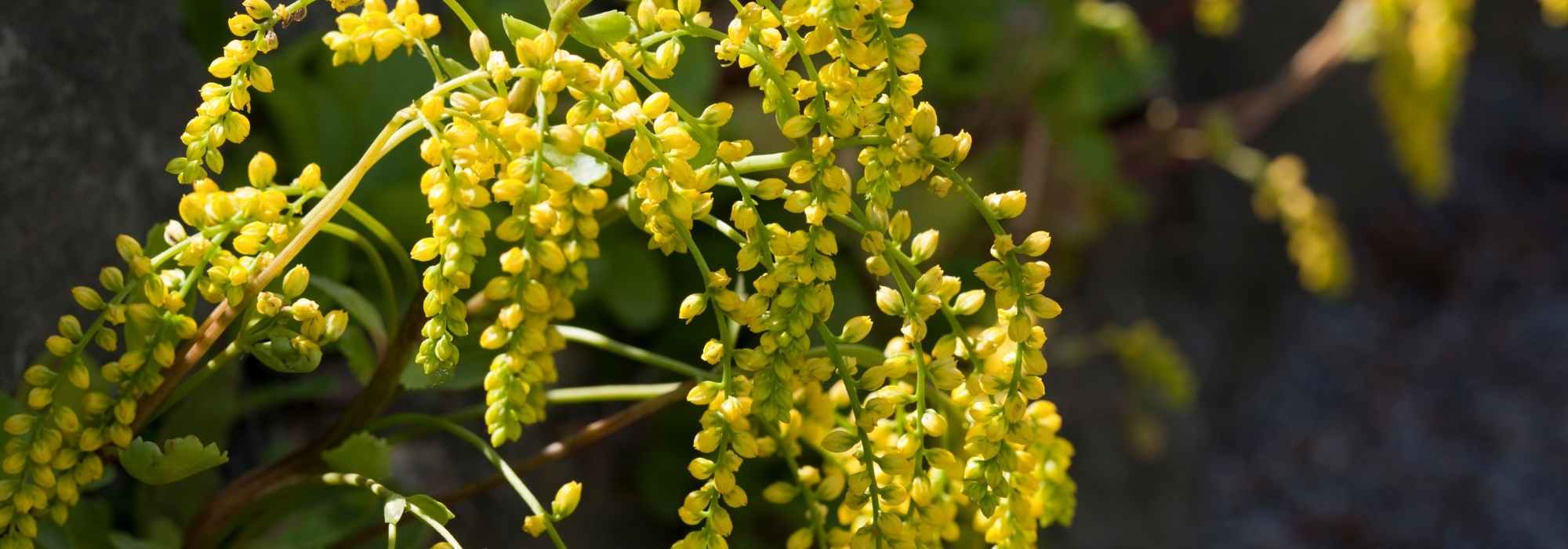
Chiastophyllum or Golden drop: planting, growing
Contents
Chiastophyllum in a nutshell
- Chiastophyllum is a perfect evergreen groundcover for partial shade and cool rockeries
- It forms a beautiful uniform or variegated carpet of succulent leaves all year round
- It offers a dazzling bright yellow flowering in summer
- It thrives in any well-drained soil, even poor ones
- Hardy, it requires virtually no maintenance
A word from our expert
The Chiastophyllum, more commonly known as “Golden Drop” is an excellent small evergreen groundcover for partial shade. In the garden, this perennial from the family of crassulaceae offers the advantage of carpeting the ground with its evergreen foliage. Well-established in cool, well-drained soil, it gradually forms dense carpets of solid or variegated leaves depending on the species, bright green in Chiastophyllum oppositifolium, or cream-variegated in its cultivar ‘Variegatum’, also known as ‘Jim’s Pride’.
At the end of spring and in summer, the Chiastophyllum rewards us with a dazzling flowering formed of trailing panicles of golden yellow borne on tall stems.
Easy to grow and low-maintenance, it brightens up the cool, shady corners of the garden, borders, a cool rockery, the edges of a waterfall, and can also be interspersed in the cracks of walls and low walls or even spill beautifully from a basin.
Discover this succulent, spreading, and evergreen perennial!
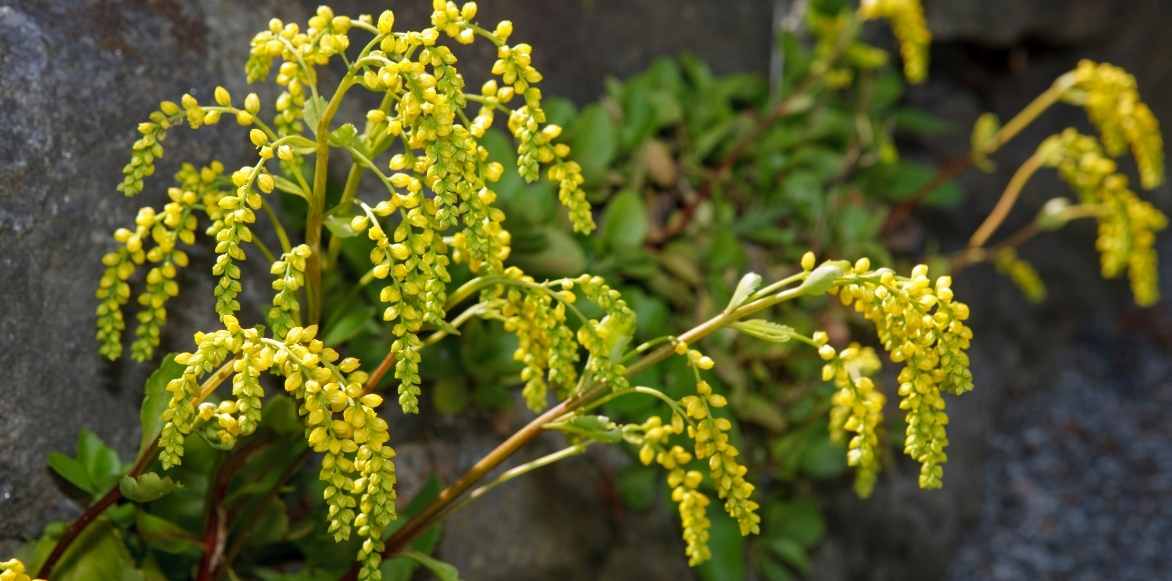
Chiastophyllum
Description and Botany
Botanical data
- Latin name Chiastophyllum oppositifolium
- Family Crassulaceae
- Common name Gold Drop
- Flowering May to July
- Height 0.15 to 0.30 m
- Sun exposure partial shade, shade
- Soil type All, well-drained, moist
- Hardiness -15°C and above
The Chiastophyllum, also known as Gold Drop, is a spreading perennial belonging to the Crassulaceae family, just like Sedum. This plant originates from the mountainous regions of the Caucasus and thrives in humus-bearing areas and shaded or partially shaded rockeries. The sole representative of the genus is the Chiastophyllum oppositifolium. It has given rise to the cultivar ‘Variegatum’ (also known as ‘Jim’s Pride’) selected for its variegated foliage.
This plant grows in small rosettes, gradually forming a persistent groundcover of 15 to 20 cm in height. Once well established, it develops almost without limit.
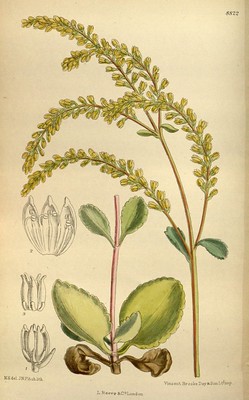
Chiastophyllum oppositifolium, botanical illustration
These rhizomatous stems root in various places, covering an area of about 25 to 30 cm, without ever becoming invasive. The short aerial stems develop persistent foliage, forming a beautiful carpet of fleshy leaves. The leaves, measuring 4 to 5 cm in length, are opposite, fleshy, ovate to round, with a coarsely crenate or undulate edge. They are a beautiful bright green or blue-green, edged with cream in the Chiastophyllum oppositifolium ‘Variegatum’. The leaves located on the lower part of the stems are tinged with rust.
From late spring through summer, this leafy carpet is illuminated by a profusion of small, very bright yellow flowers, gathered in long, slightly drooping clusters, hence its vernacular name “gold drop”. On erect red or green stems, arching spikes of campanulate flowers with five petals measuring 3-5 mm appear, resembling those of lily of the valley.
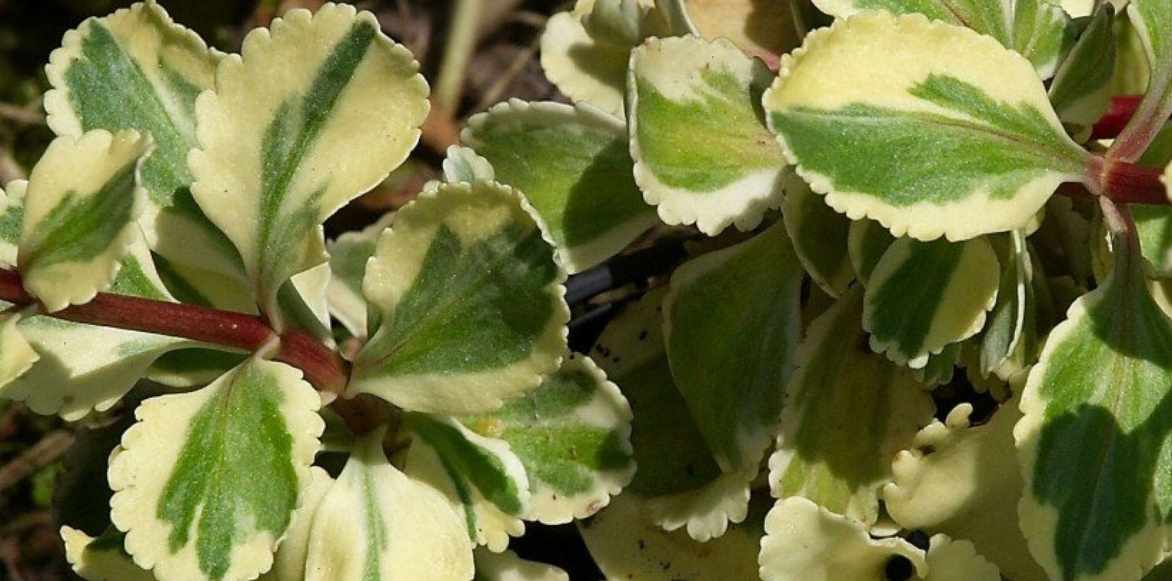
Variegated gold drop
Main species and varieties
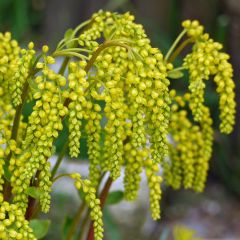
Chiastophyllum oppositifolium
- Flowering time July, August
- Height at maturity 15 cm
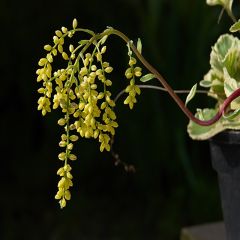
Chiastophyllum oppositifolium Variegatum
- Flowering time July, August
- Height at maturity 15 cm
Discover other Chiastophyllum
View all →Available in 1 sizes
Available in 1 sizes
Planting
Where to plant Golden Stonecrop?
The Chiastophyllum oppositifolium is a plant for partial shade and woodland. Be careful, as in too dense shade, its flowering may be minimal! In the north of the Loire, it will thrive in non-burning sunlight. Native to the mountainous regions of the Caucasus, it is hardy down to -18°C: its foliage remains evergreen even in negative temperatures.
It flourishes in light, cool to moist soil, very rich in humus and always very well-drained. It dislikes heavy or clayey soils. Ideally, the substrate should be loamy-sandy or clayey-sandy, although Golden Stonecrop adapts to most soils. It is a good plant for calcareous and well-drained soils where it will form clumps that expand over time but remain easy to control. In soils that retain too much moisture, planting on a raised bed is preferable.
The Chiastophyllum makes an excellent evergreen groundcover in woodland to dress up shady areas where nothing grows, under a bench, by a waterfall, in paving, or in the cracks of walls and low walls. It will brighten an alpine or cool rockery, a border of shrub or perennial beds, the edges of paths or even living walls. It even enjoys being planted in pots or bowls from which it will spill beautifully. It is a plant that suits living walls in partial shade.
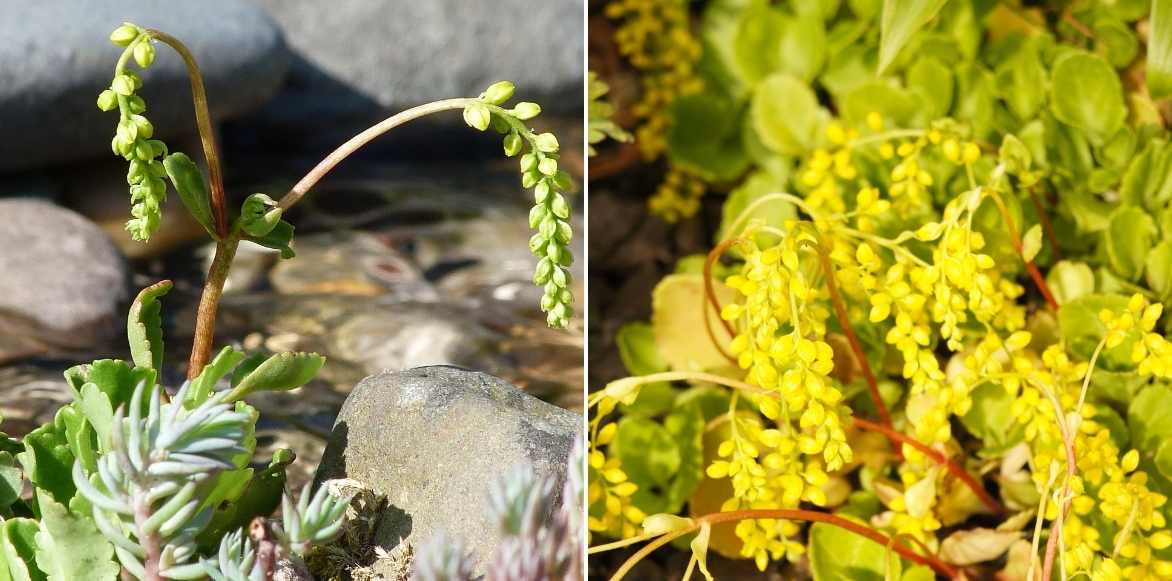
Foliage and flowering of Chiastophyllum
When to plant Chiastophyllum oppositifolium?
Planting of Chiastophyllum should be done in spring or autumn, avoiding periods of frost and drought. Autumn planting will encourage good rooting before the following summer.
How to plant it?
In the ground
Space the plants about 25 cm apart and count 5 to 10 plants per m² to create a beautiful carpet of foliage. The mix in which you plant should be light, moderately fertile, and draining.
- Dig a hole about 5 to 10 cm deep
- Loosen the soil deeply and lighten it with stones or gravel
- Place the plant in the centre of the hole, keeping the collar of the root ball level with the soil
- Mix the soil with sand and a bit of well-matured compost or planting mix
- Firm it down
- Water generously and then regularly to encourage establishment
- Mulch with pebbles or gravel
In a pot
Choose a terracotta pot of at least 30 cm in diameter and 40 cm in depth. Plan for at least 3 to 5 young plants.
- At the bottom of the pot, spread a layer of clay balls or gravel to aid drainage
- Plant in a light, well-draining compost suitable for cacti
- Mulch with a mineral mulch
- Place the pot in partial shade
Read also
10 plants to create a shady rockeryWhen and how to sow Chiastophyllum oppositifolium?
Under Shelter
You can collect seeds from flowers. Sowing of Gold Drop can be done from January or February, in a cold greenhouse or under a frame, as the seeds require cold to break their dormancy. If you sow later, ensure to place the seeds in the refrigerator for a few weeks. Germination of chiastophyllum seeds can take several weeks.
- Fill a seed tray with special seed compost
- Sow thinly on the substrate and press down very lightly
- Cover with a fine layer of sieved compost
- Water gently
- Keep the substrate moist but not waterlogged until germination
- Transplant when the seedlings have at least 2 ranks of leaves
- Place the pots in the shade during summer and protect from frost in winter
- Transplant into the ground in the following spring
Maintenance and Care
In Open Ground
Well established in a partially shaded position, the golden drop requires little attention. It only needs very limited maintenance. It prefers cool soils that are not too dry. This plant simply needs sufficient moisture at its base, especially in summer or if rainfall is insufficient. Careful watering is essential during the summer following planting. Watering should be moderate but frequent. Therefore, ensure you water it regularly, especially if it is dry.
Apply a good mineral mulch in spring, especially in the first few years after planting, to keep the base cool and reduce weeding. After flowering, tidy up the clumps by cutting back faded flowers and damaged stems.
⇒ In humid weather, follow our advice to protect its foliage from slugs and snails!
In Pots
Keep the substrate cool during the summer period; the soil should not dry out completely. Adding compost at the base 2 to 3 times during the growing season improves its growth and encourages flowering. In cold regions, protect the stump with fallen leaves in winter. Top up in early spring and repot every 4-5 years depending on the plant’s development.
Multiplication
Chiastophyllum oppositifolium propagates naturally through its rootstock. As mentioned earlier, it can also be multiplied by sowing. However, clump division in autumn or propagation by cuttings in spring are also options.
Clump Division
- Using a spade, divide the clump into several well-rooted sections
- Replant these parts immediately in the ground or in pots
Propagation by Cuttings
In spring, this is done on herbaceous stems.
- Select stems about 5-10 cm long and cut them just above a leaf
- Remove the flowers and leaves from the bottom of the stems
- Insert these cuttings into pots filled with well-draining potting mix
- Gently firm the mix around the stems
- Regularly mist the cuttings
- Place them under a cold frame during the first year
- Transplant into the ground the following spring
Associate
With its evergreen foliage in solid or variegated shades, this saxifrage family member enlivens cool areas and shaded corners of the garden.
In woodland settings, Chiastophyllum oppositifolium thrives among hostas, small ferns, epimediums, ophiopogon, and bright grasses like carex and stipa. Under trees, it can mingle with other groundcover perennials such as heucheras, geranium nodosum, and Vinca minor, to create a subtle carpet of foliage.
It is particularly interesting in light shade rockeries, alongside saxifrages, Ramonda, Lewisia, bergenias, sedum, or a Hakonechloa macra ‘Aureola’.
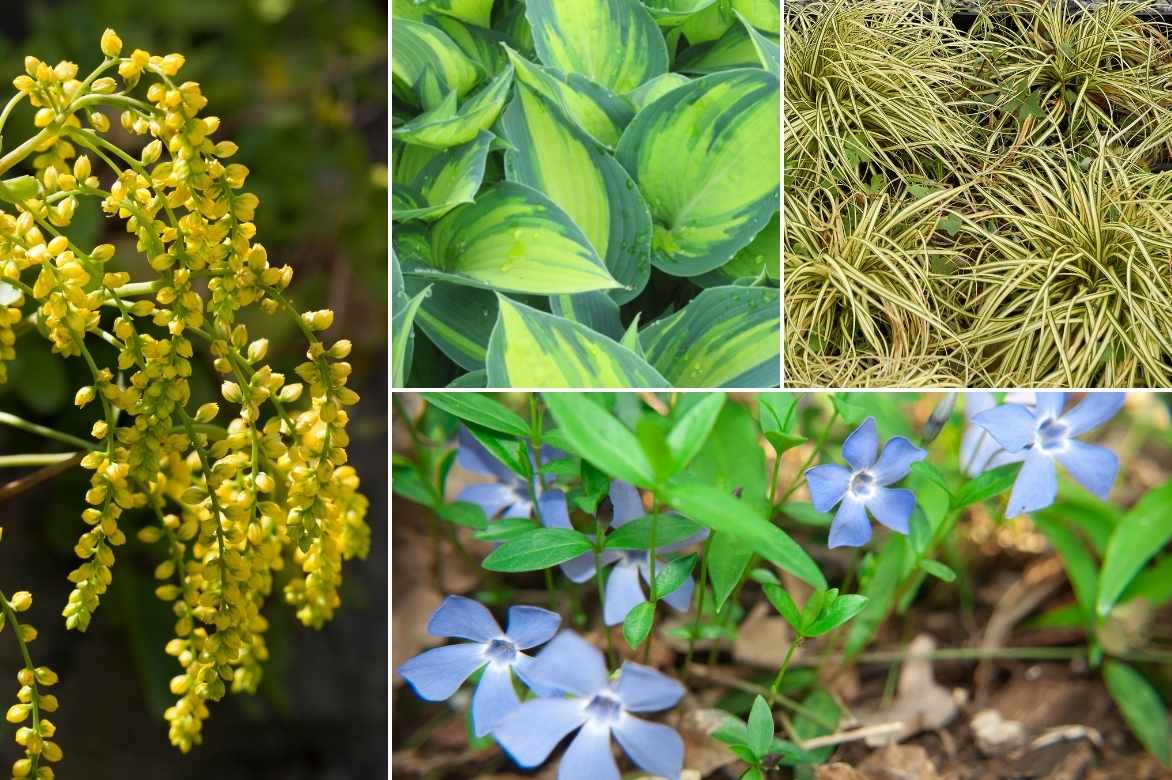
Chiastophyllum alongside Hostas ‘June’, Carex oshimensis, and Vinca minor
Useful resources
- What are the best plants to grow in woodland
- What to plant under trees?
- Subscribe!
- Contents

































Comments